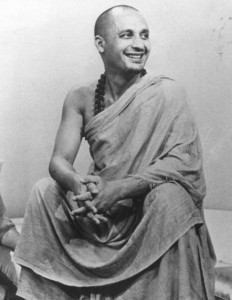Yoga Nidra (Sanskrit: योग निद्रा), also known as Yogic Sleep, is often described as a form of guided relaxation. It does indeed have the benefits of deep induced relaxation (30 minutes of Yoga Nidra is said to be an equivalent of 4 hours of sound, healthy sleep), but it is much more than just a form of recharging your batteries after pulling an all-nighter. It is a spiritual practice that brings you growth on more than one level.

THE ORIGINS
Swami Satyananda Saraswati, still as a young disciple to his guru Swami Shivananda, fell asleep one day under a tree in his master’s ashram in Rishikesh. Not far from where he was sleeping, a group of monks chanted mantras. Though unfamiliar to Swami Satyananda, after having woken up and hearing the  mantras again, he realised he knew them and was able to chant along. That is how he discovered that even as we sleep, our subtle bodies are awake and active and we can use this time to gain knowledge, change and reprogram our mental and physical patters.
mantras again, he realised he knew them and was able to chant along. That is how he discovered that even as we sleep, our subtle bodies are awake and active and we can use this time to gain knowledge, change and reprogram our mental and physical patters.
THE TECHNIQUE
In Yoga Nidra, you are asked to lie on your back in Shavasana, completely relaxed, as a voice of the teacher guides you through various stages of relaxation, body and breath awareness, visualization etc. All those stages are particularly designed to bring you into an alpha state, one you experience just before you fall asleep. In this condition, you stay relaxed and at the same time focused and aware. Once you reach that space in between the waking and dreaming realm, you maintain it throughout the duration of the practice, putting your body and your thinking mind to sleep, yet remaining aware and conscious, following the instructions, without analyzing or questioning them.
Three rules of Yoga Nidra:
- try not to move your body during the duration of Yoga Nidra;
- keep your eyes closed throughout the practice;
- follow the instructions, focus, do not fall asleep.
HOW DOES IT WORK?
The subtle always governs the gross. The mind has power over the body. Our emotions and moods influence the way we physically feel and react. For example, imagine you are very hungry and are just about to sit down for a nice meal, but then suddenly you get a message with a very bad news – your house just burned down, your partner breaks up with you, your boss tells you you are fired – imagine what you will. All of the sudden your apetite is gone. More than that, you cannot bare the thought of food. The mind took over and the bodily functions and demands are no longer your priority.
This is how the Placebo effect works. When you are convinced of something, without a shred of doubt, your body will follow. Moreover, the world around you will reshape itself to fit your belief. That’s why they say if you believe something strong enough, the whole Universe will bend over backwards to make it happen.
The subconscious mind is even subtler than the conscious mind. That is why we are governed by the deep rooted thought- and emotion patterns. Those are quite difficult to change, as we are not aware of them or their origins. One way to get to the unconscious and subconscious patterns is through the equanimity, best experienced in meditation. Another way is through the Yoga Nidra.
In Yoga Nidra, you are asked to take a resolve, a sankalpa, in the beginning and end of the practice, and repeat it three times in your mind as a positive statement, and with a feeling as if it was already coming true, manifesting in your life. In the alpha state, the statement you take transgresses the conscious, doubtful mind and is planted directly deep in the subconcious (or the subtle body). You are literally convincing yourself that the affirmation you take is true.
It is important to choose your resolve carefully and, in order to plant it deep and nourish it until it grows, repeat the same sankalpa over a period of time. Then, it is bound to come true.
